Predicting SARS-CoV-2 Weather-Induced Seasonal Virulence from Atmospheric Air Enthalpy
Abstract
1. Introduction
- -
- At the stage of inspection, to establish an optimal time window sufficiently extended to allow: (i) ascertaining the onset of the epidemic, and (ii) acquiring epidemiological data sufficient for statistical purposes; but at the same time, not too prolonged so that: (iii) the community could still be considered as a nearly isolated system with respect to major external forcing independent variables (number of international travellers; degeneration into pandemic), and that (iv) inner forcing independent variables (government measures; anthropogenic factors influencing the spread of the infection) could not yet markedly act. In the present paper, for the time window of inspection, the order of magnitude of one month has been assumed.
- -
- At the stage of application: (i) to balance the enthalpy risk in the medium to long term with the constellation of other risk factors involved in the determinism of the pandemic, and (ii) to limit its use to geographic locations where the concept of seasonality has a sense in itself.
2. Materials and Methods
3. Enthalpy Rationale
4. Results
4.1. Elaboration of Available Literature Data
4.2. The Present Investigation
5. Proposal of an Enthalpy-Based Risk Scale
5.1. Risk Assessment
5.2. Validation
5.3. Limitations
6. Discussion
7. Conclusions
Author Contributions
Funding
Conflicts of Interest
References
- Lowen, A.C.; Mubareka, S.; Steel, J.; Palese, P. Influenza Virus Transmission Is Dependent on Relative Humidity and Temperature. PLoS Pathog. 2007, 3, e151. [Google Scholar] [CrossRef] [PubMed]
- Yang, W.; Marr, L.C. Mechanisms by Which Ambient Humidity May Affect Viruses in Aerosols. Appl. Environ. Microbiol. 2012, 78, 6781–6788. [Google Scholar] [CrossRef] [PubMed]
- Tang, J.W. The effect of environmental parameters on the survival of airborne infectious agents. J. R. Soc. Interface 2009, 6, 737–746. [Google Scholar] [CrossRef] [PubMed]
- Hanley, B.P.; Borup, B. Aerosol influenza transmission risk contours: A study of humid tropics versus winter temperate zone. Virol. J. 2010, 7, 98. [Google Scholar] [CrossRef]
- Chan, K.H.; Peiris, J.S.M.; Lam, S.Y.; Poon, L.L.M.; Yuen, K.Y.; Seto, W.H. The Effects of Temperature and Relative Humidity on the Viability of the SARS Coronavirus. Adv. Virol. 2011, 2011, 734690. [Google Scholar] [CrossRef]
- Memarzadeh, F. Literature review of the effect of temperature and humidity on viruses. ASHRAE Trans. 2012, 118, 1049–1060. [Google Scholar]
- Van Doremalen, N.; Bushmaker, T.; Munster, V.J. Stability of Middle East respiratory syndrome coronavirus (MERS-CoV) under different environmental conditions. Eurosurveillance 2013, 18, 20590. [Google Scholar] [CrossRef]
- Van Doremalen, N.; Bushmaker, T.; Morris, D.H.; Holbrook, M.G.; Gamble, A.; Williamson, B.N.; Lloyd-Smith, J.O. Aerosol and Surface Stability of SARS-CoV-2 as Compared with SARS-CoV-1. N. Engl. J. Med. 2020, 382, 1564–1567. [Google Scholar] [CrossRef]
- Spena, A.; Palombi, L.; Corcione, M.; Carestia, M.C.; Spena, V.A. On the optimal indoor air conditions for SARS-CoV-2 inactivation. An enthalpy-based approach. Int. J. Environ. Res. Public Health 2020, 17, 6083. [Google Scholar] [CrossRef]
- Xie, J.; Zhu, Y. Association between ambient temperature and COVID-19 infection in 122 cities from China. Sci. Total. Environ. 2020, 724, 138201. [Google Scholar] [CrossRef]
- Ma, Y.; Zhao, Y.; Liu, J.; He, X.; Wang, B.; Fu, S.; Yan, J.; Niu, J.; Zhou, J.; Luo, B. Effects of temperature variation and humidity on the death of COVID-19 in Wuhan, China. Sci. Total. Environ. 2020, 724, 138226. [Google Scholar] [CrossRef] [PubMed]
- Tosepu, R.; Gunawan, J.; Effendy, D.S.; Ahmad, L.O.A.I.; Lestari, H.; Bahar, H.; Asfian, P. Correlation between weather and Covid-19 pandemic in Jakarta, Indonesia. Sci. Total. Environ. 2020, 725, 138436. [Google Scholar] [CrossRef] [PubMed]
- Liu, J.; Zhou, J.; Yao, J.; Zhang, X.; Li, L.; Xu, X.; He, X.; Wang, B.; Fu, S.; Niu, T.; et al. Impact of meteorological factors on the COVID-19 transmission: A multi-city study in China. Sci. Total. Environ. 2020, 726, 138513. [Google Scholar] [CrossRef] [PubMed]
- Ahmadi, M.; Sharifi, A.; Dorosti, S.; Ghoushchi, S.J.; Ghanbari, N. Investigation of effective climatology parameters on COVID-19 outbreak in Iran. Sci. Total. Environ. 2020, 729, 138705. [Google Scholar] [CrossRef]
- Şahin, M. Impact of weather on COVID-19 pandemic in Turkey. Sci. Total. Environ. 2020, 728, 138810. [Google Scholar] [CrossRef]
- Bashir, M.F.; Ma, B.; Bilal; Komal, B.; Tan, D.; Bashir, M. Correlation between climate indicators and COVID-19 pandemic in New York, USA. Sci. Total Environ. 2020, 728, 138835. [Google Scholar] [CrossRef]
- Prata, D.N.; Rodrigues, W.; Bermejo, P.H. Temperature significantly changes COVID-19 transmission in (sub)tropical cities of Brazil. Sci. Total Environ. 2020, 729, 138862. [Google Scholar] [CrossRef]
- Wu, Y.; Jing, W.; Liu, J.; Ma, Q.; Yuan, J.; Wang, Y.; Du, M.; Liu, M. Effects of temperature and humidity on the daily new cases and new deaths of COVID-19 in 166 countries. Sci. Total. Environ. 2020, 729, 139051. [Google Scholar] [CrossRef]
- Shaman, J.; Kohn, M. Absolute humidity modulates influenza survival, transmission, and seasonality. Proc. Natl. Acad. Sci. USA 2009, 106, 3243–3248. [Google Scholar] [CrossRef]
- Lipsitch, M.; Viboud, C. Influenza seasonality: Lifting the fog. Proc. Natl. Acad. Sci. USA 2009, 106, 3645–3646. [Google Scholar] [CrossRef]
- Shaman, J.; Pitzer, V.E.; Viboud, C.; Grenfell, B.T.; Lipsitch, M. Absolute humidity and the seasonal onset of influenza in the continental United States. PLoS Biol. 2010, 8, e1000316. [Google Scholar] [CrossRef]
- Ud-Dean, S.M.; Ud-Dean, S.M. Structural explanation for the effect of humidity on persistence of airborne virus: Seasonality of influenza. J. Theor. Biol. 2010, 264, 822–829. [Google Scholar] [CrossRef] [PubMed]
- Yang, W.; Elankumaran, S.; Marr, L.C. Relationship between Humidity and Influenza A Viability in Droplets and Implications for Influenza’s Seasonality. PLoS ONE 2012, 7, e46789. [Google Scholar] [CrossRef] [PubMed]
- World Health Organization. Report of the WHO-China Joint Mission on Coronavirus Disease 2019, 16–24 February 2020. 2020. Available online: https://www.who.int/emergencies/diseases/novel-coronavirus-2019?gclid=EAIaIQobChMIp67mz8GV6gIVisqyCh0PUwvOEAAYASAAEgK2_vD_BwE (accessed on 5 June 2020).
- Sajadi, M.M.; Habibzadeh, P.; Vintzileos, A.; Shokouhi, S.; Miralles-Wilhelm, F.; Amoroso, A. Temperature and Latitude Analysis to Predict Potential Spread and Seasonality for COVID-19. SSRN Electron. J. 2020, 3550308. [Google Scholar] [CrossRef] [PubMed]
- ASHRAE Handbook of Fundamentals. In Chapter 6—Psychrometrics; American Society of Heating, Refrigeration and Air-Conditioning Engineers: Atlanta, GA, USA, 2005; p. 79.
- Hyland, R.W.; Wexler, A. Formulations for the Thermodynamic Properties of the Saturated Phases of H2O from 173.15 K to 473.15 K; ASHRAE Transactions: San Diego, CA, USA, 1983; Volume 89, pp. 500–519. [Google Scholar]
- Taha, H. Urban climates and heat islands: Albedo, evapotranspiration, and anthropogenic heat. Energy Build. 1997, 25, 99–103. [Google Scholar] [CrossRef]
- Santamouris, M. Energy and Climate in the Urban Built Environment, 1st ed.; James & James Science Publishers Ltd.: London, UK, 2001. [Google Scholar]
- Santamouris, M. Cooling the cities—A review of reflecting and green roof mitigation technologies to fight heat islands and improve comfort in urban environments. Solar Energy 2014, 103, 682–703. [Google Scholar] [CrossRef]
- Briz-Redón, A.; Serrano-Aroca, A. The effect of climate on the spread of the COVID-19 pandemic: A review of findings, and statistical and modelling techniques. Prog. Phys. Geogr. Earth Environ. 2020, 44, 591–604. [Google Scholar] [CrossRef]
- Available online: https://www.timeanddate.com/ (accessed on 4 May 2020).
- Makinen, T.M.; Juvonen, R.; Jokelainen, J.; Harju, T.H.; Peitso, A.; Bloigu, A.; Silvennoinen-Kassinen, S.; Leinonen, M.; Hassi, J. Cold temperature and low humidity are associated with increased occurrence of respiratory tract infections. Respir. Med. 2009, 103, 456–462. [Google Scholar] [CrossRef]
- The KIAS-Study Group; Jaakkola, K.; Saukkoriipi, A.; Jokelainen, J.; Juvonen, R.; Kauppila, J.; Vainio, O.; Ziegler, T.T.; Rönkkö, E.; Jaakkola, J.J.K.; et al. Decline in temperature and humidity increases the occurrence of influenza in cold climate. Environ. Health 2014, 13, 22. [Google Scholar] [CrossRef]
- Davis, R.E.; Dougherty, E.; McArthur, C. Cold, dry air is associated with influenza and pneumonia mortality in Auckland, New Zealand. Influenza Other Respir Viruses 2016, 10, 310–313. [Google Scholar] [CrossRef]
- Ikäheimo, T.M.; Jaakkola, K.; Jokelainen, J.; Saukkoriipi, A.; Roivainen, M.; Juvonen, R.; Vainio, O.; Jaakkola, J.J. A Decrease in Temperature and Humidity Precedes Human Rhinovirus Infections in a Cold Climate. Viruses 2016, 8, 244. [Google Scholar] [CrossRef] [PubMed]
- Ficetola, G.F.; Rubolini, D. Climate affects global patterns of CoViD-19 early outbreak dynamics. medRxiv 2020. to be published. [Google Scholar]
- Available online: http://www.worldclim.org/ (accessed on 4 May 2020).
- Cai, J.; Sun, W.; Huang, J.; Gamber, M.; Wu, J.; He, G. Indirect Virus Transmission in Cluster of COVID-19 Cases, Wenzhou, China, 2020. Emerg. Infect. Dis. 2020, 26, 1343–1345. [Google Scholar] [CrossRef] [PubMed]
- Weber, T.P.; Stilianakis, N.I. Inactivation of influenza A viruses in the environment and models oftransmission. J. Infect. 2008, 57, 361–373. [Google Scholar] [CrossRef] [PubMed]
- Després, V.R.; Huffman, J.A.; Burrows, S.M.; Hoose, C.; Safatov, A.S.; Buryak, G.; Fröhlich-Nowoisky, J.; Elbert, W.; Andreae, M.O.; Pöschl, U.; et al. Primary biological aerosol particles in the atmosphere: A review. Tellus B Chem. Phys. Meteorol. 2012, 64. [Google Scholar] [CrossRef]
- Demertzis, K.; Tsiotas, D.; Magafas, L. Modeling and Forecasting the COVID-19 Temporal Spread in Greece: An Exploratory Approach Based on Complex Network Defined Splines, Preprint. 2020. Available online: https://www.researchgate.net/publication/341148369_Modeling_and_forecasting_the_COVID-19_temporal_spread_in_Greece_an_exploratory_approach_based_on_complex_network_defined_splines (accessed on 15 June 2020).
- Huff, D. How to Lie With Statistics; W. W. Norton & Co.: New York, NY, USA, 1954. [Google Scholar]
- Magazzino, C.; Mele, M.; Schneider, N. The relationship between air pollution and COVID-19-related deaths: An application to three French cities. Appl. Energy 2020, 279, 115835. [Google Scholar] [CrossRef] [PubMed]
- Jahangiri, M.; Jahangiri, M.; Najafgholipour, M. The sensitivity and specificity analyses of ambient temperature and population size on the transmission rate of the novel coronavirus (COVID-19) in different provinces of Iran. Sci. Total Environ. 2020, 728, 138872. [Google Scholar] [CrossRef]
- Yu, I.T.; Li, Y.; Wong, T.W.; Tam, W.; Chan, A.T.; Lee, J.H.; Ho, T. Evidence of airborne transmission of the SARS. N. Engl. J. Med. 2004, 350, 1731–1739. [Google Scholar] [CrossRef]
- Cássaro, F.A.; Pires, L.F. Can we predict the occurrence of COVID-19 cases? Considerations using a simple model of growth. Sci. Total. Environ. 2020, 728, 138834. [Google Scholar] [CrossRef]
- World Health Organization. Management of Ill Travelers at Points of Entry—International Airports, Seaports and Ground Crossings—In the Context of CoViD-19 Outbreak—Interim Guidance; Technical Report; World Health Organization: Geneva, Switzerland, 2020. [Google Scholar]
- Schaffer, F.L.; Soergel, M.E.; Straube, D.C. Survival of airborne influenza virus: Effects of propagating host, relative humidity, and composition of spray fluids. Arch. Virol. 1976, 51, 263–273. [Google Scholar] [CrossRef]
- Sunwoo, Y.; Chou, C.; Takeshita, J.; Murakami, M.; Tochihara, Y. Physiological and Subjective Responses to Low Relative Humidity. J. Physiol. Anthr. 2006, 25, 7–14. [Google Scholar] [CrossRef] [PubMed]
- Sunwoo, Y.; Chou, C.; Takeshita, J.; Murakami, M.; Tochihara, Y. Physiological and Subjective Responses to Low Relative Humidity in Young and Elderly Men. J. Physiol. Anthr. 2006, 25, 229–238. [Google Scholar] [CrossRef] [PubMed]
- Raines, K.S.; Doniach, S.; Bhanot, G. The transmission of SARS-CoV-2 is likely comodulated by temperature and by relative humidity. medRxiv 2020. [Google Scholar] [CrossRef]
- Coccia, M. Factors determining the diffusion of COVID-19 and suggested strategy to prevent future accelerated viral infectivity similar to COVID. Sci. Total. Environ. 2020, 729, 138474. [Google Scholar] [CrossRef] [PubMed]
- Conticini, E.; Frediani, B.; Caro, D. Can atmospheric pollution be considered a co-factor in extremely high level of SARS-CoV-2 lethality in Northern Italy? Environ. Pollut. 2020. to be published. [Google Scholar] [CrossRef] [PubMed]
- Xu, R.; Rahmandad, H.; Gupta, M.; DiGennaro, C.; Ghaffarzadegan, N.; Amini, H.; Jalali, M.S. The modest impact of weather and air pollution on COVID-19 transmission. MedRXiv 2020. [Google Scholar] [CrossRef]
- Setti, L.; Passarini, F.; GennaroGd, G.A.; Palmisani, J.; Buono, P. Relazione circa l’effetto dell’inquinamento da particolato atmosferico e la diffusione di virus nella popolazione. Position Pap. 2020. Available online: https://projects.iq.harvard.edu/covid-pm/publications/relazione-circa-l%E2%80%99effetto-dell%E2%80%99inquinamento-da-particolato-atmosferico-e-la (accessed on 9 May 2020).
- Wu, X.; Nethery, R.C.; Sabath, B.M.; Braun, D.; Dominici, F. Exposure to air pollution and COVID-19 mortality in the United states. MedRXiv 2020. to be published. [Google Scholar]
- Nicastro, F.; Sironi, G.; Antonello, E.; Bianco, A.; Biasin, M.; Brucato, J.R.; Trabattoni, D. Forcing Seasonality of Influenza-like Epidemics with Daily Solar Resonance. Iscience 2020, 23, 101605. [Google Scholar] [CrossRef]
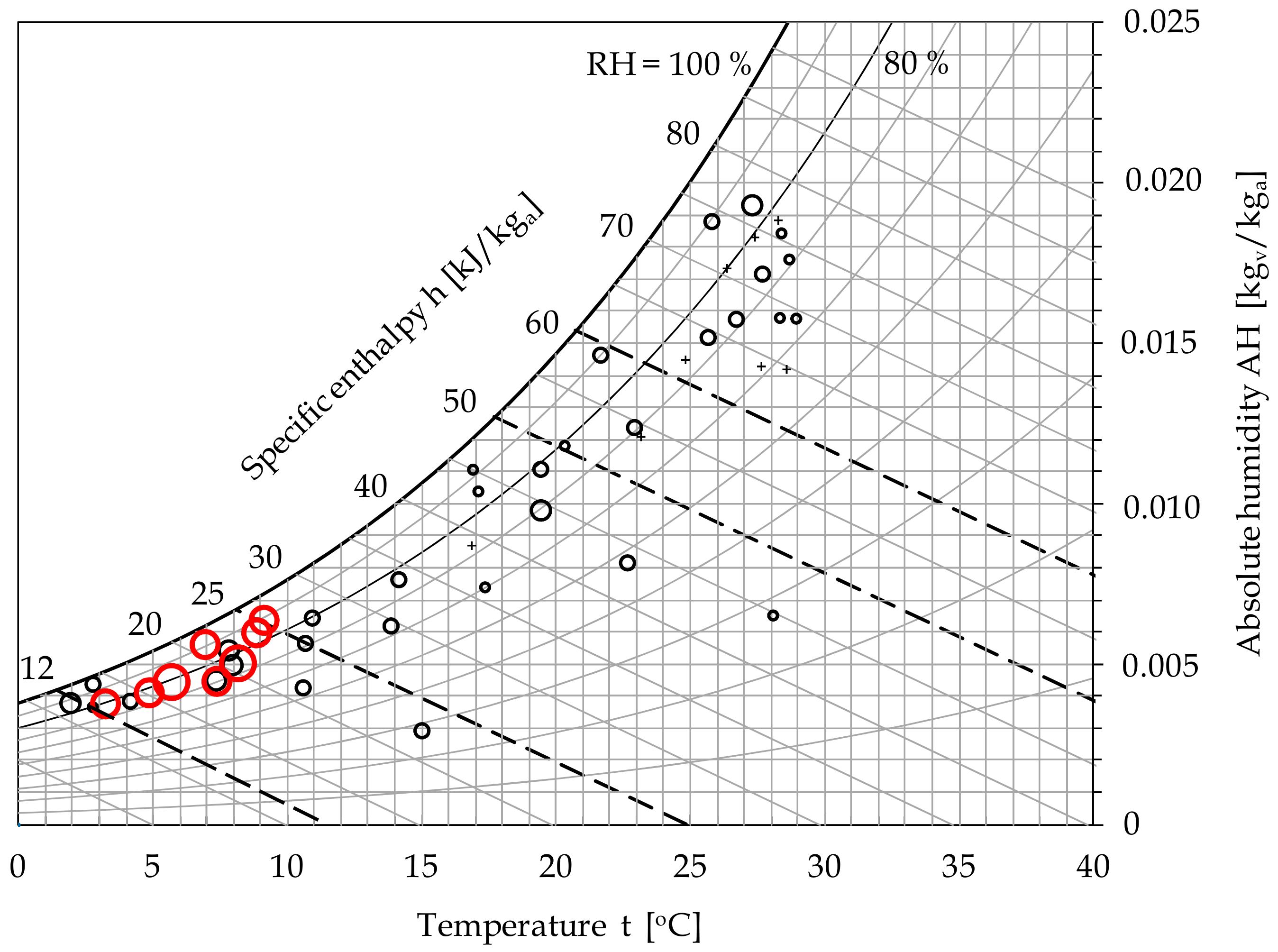
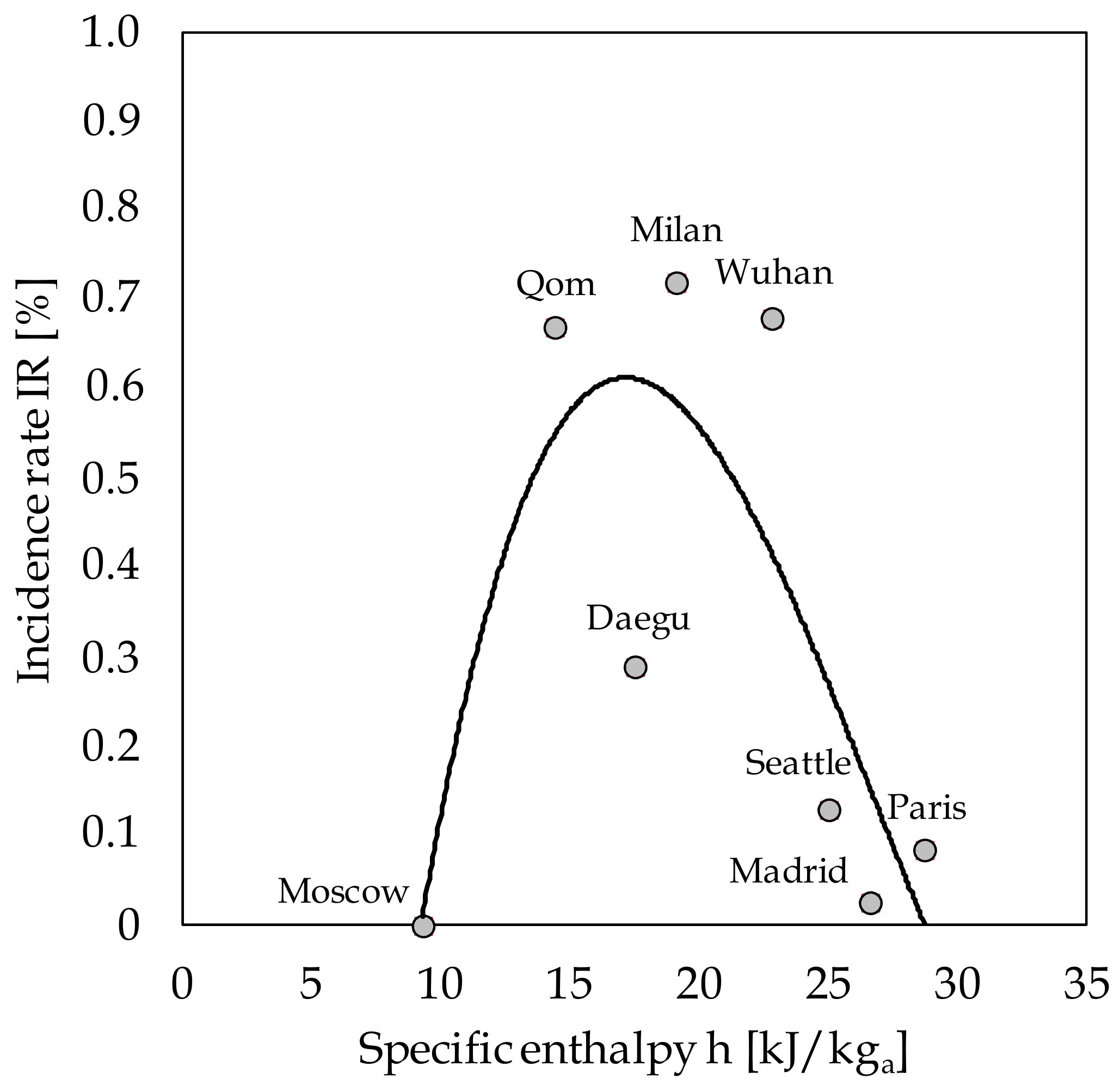
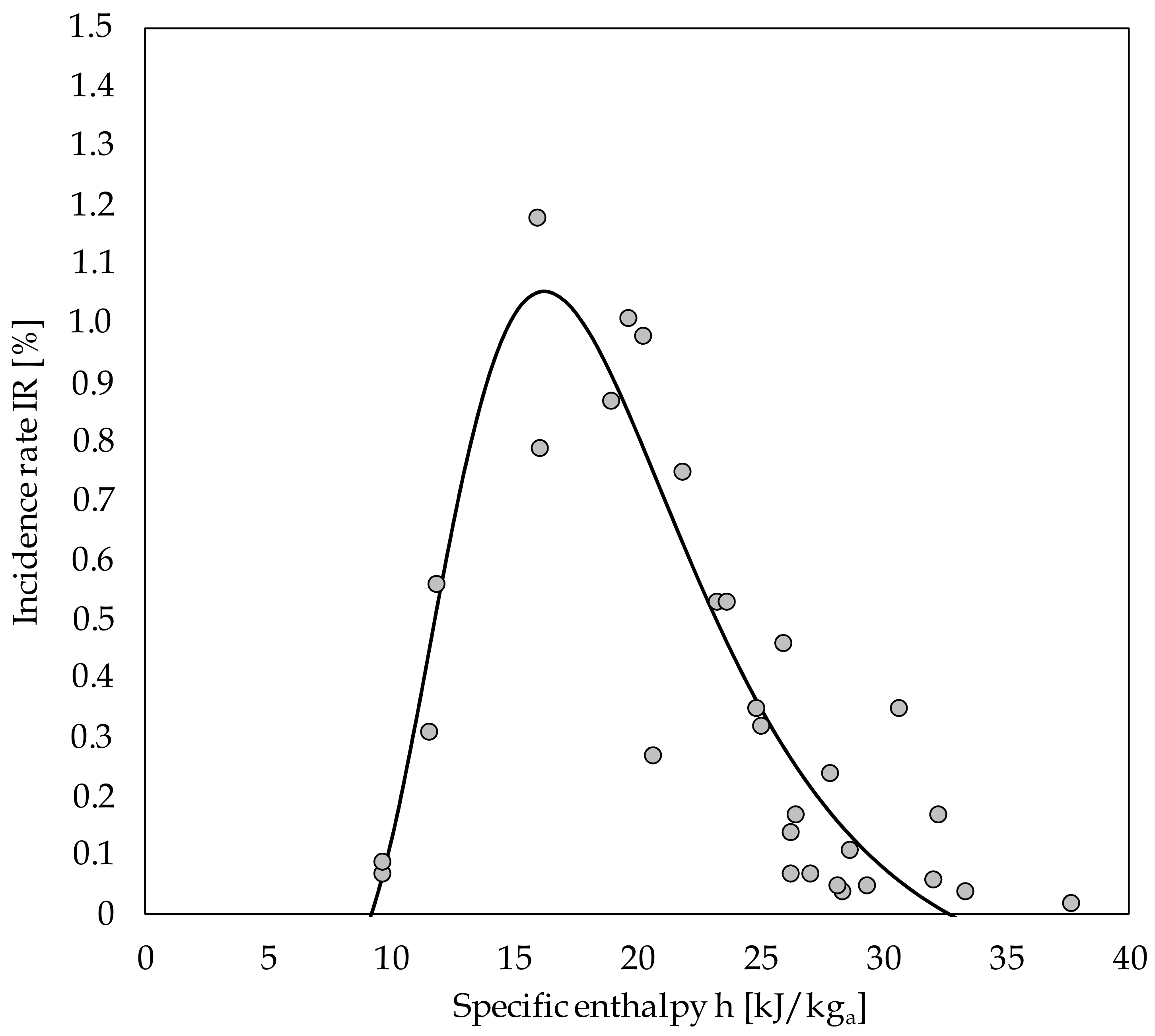
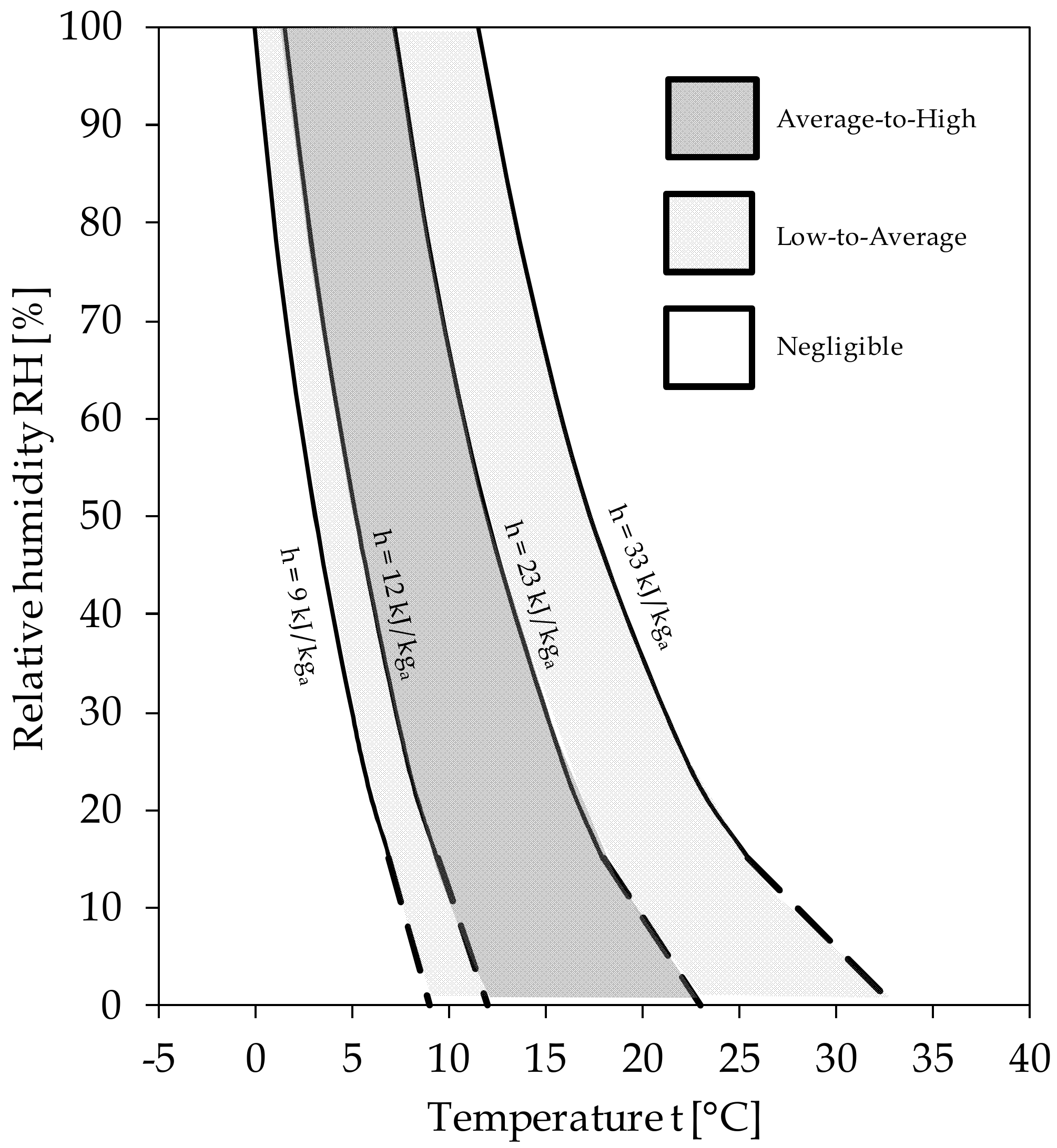

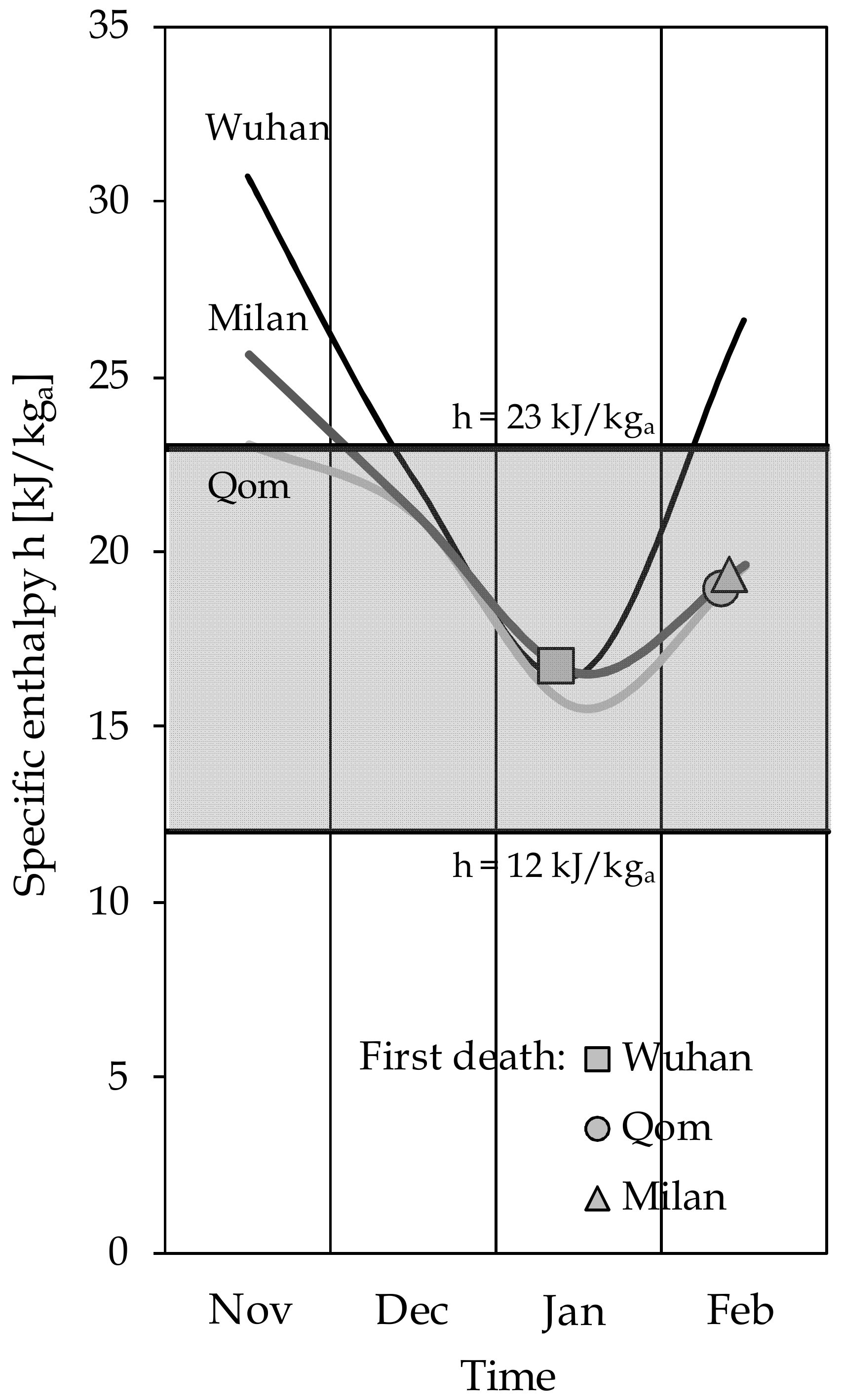
| Provinces | Population | Cases After 40 Days | IR (%) | h [kJ/kg Dry-Air] |
|---|---|---|---|---|
| Alessandria | 421,284 | 2248 | 0.53 | 23.6 |
| Aosta | 125,666 | 993 | 0.79 | 16.0 |
| Bari | 1,251,994 | 886 | 0.07 | 27.0 |
| Bergamo | 1,114,590 | 9712 | 0.87 | 18.9 |
| Bolzano | 531,178 | 1644 | 0.31 | 11.5 |
| Brescia | 1,265,954 | 9477 | 0.75 | 21.8 |
| Brindisi | 392,975 | 428 | 0.11 | 28.6 |
| Cagliari | 431,038 | 191 | 0.04 | 33.3 |
| Campobasso | 221,238 | 191 | 0.09 | 9.6 |
| Cremona | 358,955 | 4233 | 1.18 | 15.9 |
| Firenze | 1,011,349 | 1715 | 0.17 | 32.2 |
| Genova | 841,180 | 2918 | 0.35 | 30.6 |
| L’Aquila | 299,031 | 220 | 0.07 | 9.6 |
| Latina | 575,254 | 419 | 0.07 | 26.2 |
| Lodi | 230,198 | 2255 | 0.98 | 20.2 |
| Napoli | 3,084,890 | 1643 | 0.05 | 29.3 |
| Palermo | 1,252,588 | 299 | 0.02 | 37.6 |
| Parma | 451,631 | 2083 | 0.46 | 25.9 |
| Perugia | 656,382 | 950 | 0.14 | 26.2 |
| Pesaro-Urbino | 358,886 | 1919 | 0.53 | 23.2 |
| Piacenza | 287,152 | 2892 | 1.01 | 19.6 |
| Potenza | 364,960 | 162 | 0.04 | 28.3 |
| Reggio Calabria | 548,009 | 276 | 0.05 | 28.1 |
| Roma | 4,342,212 | 2714 | 0.06 | 32.0 |
| Savona | 276,064 | 654 | 0.24 | 27.8 |
| Teramo | 308,052 | 511 | 0.17 | 26.4 |
| Torino | 2,256,523 | 5985 | 0.27 | 20.6 |
| Trento | 541,098 | 3053 | 0.56 | 11.8 |
| Trieste | 234,493 | 821 | 0.35 | 24.8 |
| Verona | 962,497 | 3049 | 0.32 | 25.0 |
| Specific Enthalpy (h) Range | Level of Seasonal Virulence Risk (SVR) |
|---|---|
| h < 9 kJ/kga | Negligible |
| 9 kJ/kga ≤ h < 12 kJ/kga | Low-to-average |
| 12 kJ/kga ≤ h ≤ 23 kJ/kga | Average-to-high |
| 23 kJ/kga < h ≤ 33 kJ/kga | Low-to-average |
| h > 33 kJ/kga | Negligible |
Publisher’s Note: MDPI stays neutral with regard to jurisdictional claims in published maps and institutional affiliations. |
© 2020 by the authors. Licensee MDPI, Basel, Switzerland. This article is an open access article distributed under the terms and conditions of the Creative Commons Attribution (CC BY) license (http://creativecommons.org/licenses/by/4.0/).
Share and Cite
Spena, A.; Palombi, L.; Corcione, M.; Quintino, A.; Carestia, M.; Spena, V.A. Predicting SARS-CoV-2 Weather-Induced Seasonal Virulence from Atmospheric Air Enthalpy. Int. J. Environ. Res. Public Health 2020, 17, 9059. https://doi.org/10.3390/ijerph17239059
Spena A, Palombi L, Corcione M, Quintino A, Carestia M, Spena VA. Predicting SARS-CoV-2 Weather-Induced Seasonal Virulence from Atmospheric Air Enthalpy. International Journal of Environmental Research and Public Health. 2020; 17(23):9059. https://doi.org/10.3390/ijerph17239059
Chicago/Turabian StyleSpena, Angelo, Leonardo Palombi, Massimo Corcione, Alessandro Quintino, Mariachiara Carestia, and Vincenzo Andrea Spena. 2020. "Predicting SARS-CoV-2 Weather-Induced Seasonal Virulence from Atmospheric Air Enthalpy" International Journal of Environmental Research and Public Health 17, no. 23: 9059. https://doi.org/10.3390/ijerph17239059
APA StyleSpena, A., Palombi, L., Corcione, M., Quintino, A., Carestia, M., & Spena, V. A. (2020). Predicting SARS-CoV-2 Weather-Induced Seasonal Virulence from Atmospheric Air Enthalpy. International Journal of Environmental Research and Public Health, 17(23), 9059. https://doi.org/10.3390/ijerph17239059








